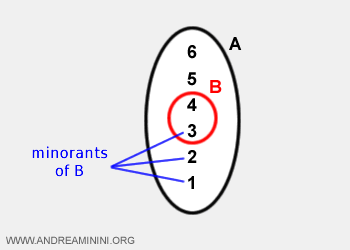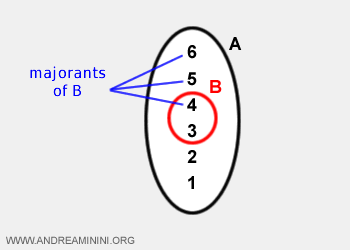Extremes of a Set
Defining the Extremes
- Every non-empty set invariably has a supremum (upper bound) and an infimum (lower bound).
- In bounded sets, the extremities are finite numbers.
- In unbounded sets, the extremities are represented by the symbols for plus or minus infinity (±∞).
A set might also be bounded above (having a finite supremum) while being unbounded below (infinite infimum), or the other way around.
Note: The supremum and infimum of a set may or may not be members of the set itself.
Delving into practical examples is beneficial for understanding the concepts of infimum and supremum.
The Infimum
For a set A and its subset B $$ B ⊆ A $$, the infimum of B is an element a∈A that is less than or equal to every element in b∈B. $$ inf(B) = a \le b \:\:\: a \in A, b \in B $$
- In bounded sets, the infimum is the highest among the lower bounds (minorants).
For instance, the infimum of B is the number 3.

- In unbounded sets, the infimum is negative infinity (-∞).
Example 1
Set A is the set of all real numbers R within the interval (-∞,+∞).
Set B is composed of 7 real numbers and is a subset of A.
$$ B = \{ 3, 4, 7, 5, 8, 9, 6 \} $$
The infimum of set B is the number three
$$ inf(B) = 3 \le b \:\:\: \forall \: b \in B $$
because the real number 3 is less or equal to all elements within set B.
Note: Here, the infimum inf(B)=3 is part of set B. However, it's not always the case.
Example 2
Set A is the set of all real numbers R within the interval (-∞,+∞).
Set B is the set of positive real numbers R+ and is a subset of A.
The infimum of set B is zero.
$$ inf(B) \le b \:\:\: \forall \: b \ \in \ B $$
It represents the greatest lower bound of the set R+.
Note: In this instance, the infimum inf(B)=0 does not belong to set B (R+) because there are infinitely many points between zero and any other positive real number.

The Supremum
For a set A and its subset B $$ B ⊆ A $$, the supremum of B is an element a∈A that is greater than or equal to every element in b∈B. $$ sup(B) = a \ge b \:\:\: a \ \in \ A \ , \ b \in B $$
- In bounded sets, the supremum is the lowest among the upper bounds (majorants).
For example, the supremum of B is 9.

- In unbounded sets, the supremum is positive infinity (+∞).
Example 1
Set A is the set of all real numbers R within the interval (-∞,+∞).
Set B comprises 7 real numbers and is a subset of A.
$$ B = \{ 3, 4, 7, 5, 8, 9, 6 \} $$
The supremum of set B is the number nine
$$ sup(B) = 9 \ge b \:\:\: \forall \: \ b \ \in B $$
because the real number 9 is greater or equal to all elements within set B.
Note: In this case, the supremum sup(B)=9 is part of set B. It's not a universal rule, though.
Example 2
Set A is the set of all real numbers R within the interval (-∞,+∞).
Set B is the set of negative real numbers R- and is a subset of A.
The lower bound of set B is negative infinity.
$$ inf(B) = - \infty \le b \:\:\: \forall \: \ b \ \in B $$
Note: Here, the lower bound inf(B)=-∞ is part of set B (R-) because the set of negative real numbers is unbounded below. Conversely, the upper bound sup(B)=0 is not part of set B (R-) as it is not a negative real number.

And so forth.
